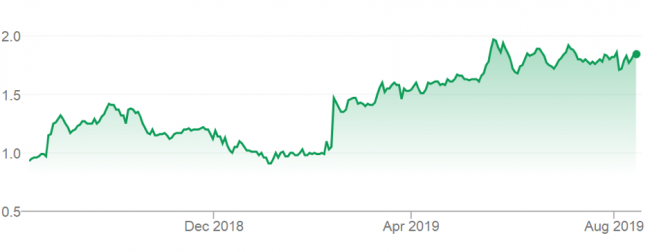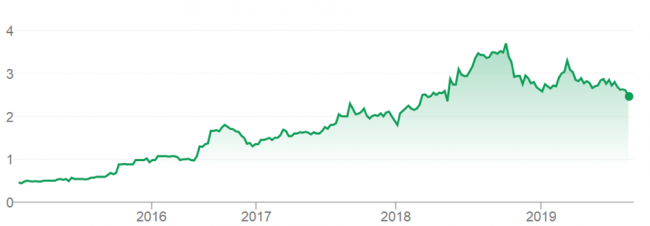Buying shares in discretionary fashion retailers is as contrarian as it gets in this market, even though some are performing well and others are undervalued. City Chic Collective (CCX) and Noni B (NBL) stand out.
There’s a long list of reasons to avoid fashion retailers. A sluggish economy, anaemic retail sales growth and patchy consumer sentiment is a terrible backdrop for discretionary retail.
David Jones in early August warned there is a “retail recession” in Australia after an asset write down. Consumers are not spending like they used to at department stores, partly because that retail model is losing favour and partly because they are seeking cheaper alternatives at discount stores or other category killers.
The latest Household, Income and Labour Dynamics Survey (HILDA) found householders were worse off now than in the 2008-09 global financial crisis on a disposable income basis. Record low wages growth and rising living costs are eating into spending power.
Structural threats compound retail’s cyclical challenge. International competition is rising as Uniqlo, H&M and other retailers grow their market share; e-commerce is taking sales from bricks-and-mortar retailers; and high leasing costs in shopping centres are crunching margins.
Several retailers have gone bust in the past 18 months and I expect more to join them. I cannot recall such a brutal market for fashion retailing, which is surprising given a reasonable unemployment rate and two interest rate cuts this year and expectations of more.
Share market dynamics are another factor. Most discretionary retailers are small-cap or mid-cap “old economy” stocks – a segment that is badly out of favour. If the recent market sell-off intensifies, amid growing fears about the global economy, retailer stocks are easy to dump.
Although some retailers look cheap, they could get cheaper or stay there for a long time if conditions deteriorate. Investors hoping for a quick turnaround must look elsewhere.
That’s the bad news. The good news is that valuations for some discretionary retailers appear as though the market has priced in recession or something worse. So it would not take much good news to get share prices higher, assuming enough investors are still looking at the stocks.
Moreover, interest rates are at record lows and heading lower. Better still, lower rates should get property prices heading higher again, sparking the so-called “wealth effect” that encourages a consumption lift.
Headlines abounded this week about a rising risk of recession and other gloom and doom. But for home-loan borrowers with reasonable job security, falling interest rates are a boon. Then there are the Federal Government’s tax cuts that are filtering their way into the economy.
Also, not all structural factors are against retailers. Population growth is a huge tailwind: Harvey Norman, JB Hi-Fi and other retailers benefit as the number of households increases, requiring extra goods. JB Hi-Fi’s latest profit result, slightly better than expected, shows there is life in good retailers.
1. City Chic Collective (CCX)
This brings me to City Chic, a fashion provider for plus-size women. City Chic used to be known as Speciality Fashion Group but last year changed its name after Speciality Fashion sold its loss-making Crossroads, Katies, Millers, Autograph and Rivers chains to Noni B for $31 million in July 2018.
The sale enabled the company to focus entirely on its high-performing City Chic business and free it from a group of lesser-performing businesses. The name change also raised awareness of City Chic’s Australian and international growth prospects.
The market liked the new directors: City Chic shares have rallied from a 52-week low of 90 cents to as high as $2. They closed this week at $1.78. That’s a fair effort for a small-cap retailer to double its share price in a market where most retail stocks are going backwards.
Investors might think it is too late to buy City Chic, given the magnitude of its rally. It would not surprise to see City Chic shares fall back or consolidate if our share market wobbles continue, as small-cap fund managers lock in profits from high-flying stocks.
Patient investors might watch and wait for better value. Any sustained price weakness could be an opportunity to buy a retailer with attractive international growth prospects.
Readers will recall my favourable views on Premier Investments and Lovisa Holdings for The Switzer Report in the past three years. Lovisa in particular has starred over that period. The main attraction of both stocks is their growing international footprint.
The same is true of City Chic. About 16% of its revenue is from the northern hemisphere and that should grow rapidly as the company expands its offshore presence.
City Chic notes research showing the women’s plus-size apparel market is worth more than $50 billion in the United States and Europe. The US is the priority; City Chic is developing a strong multi-channel digital strategy and collaborating with partners in that market.
I feel terribly underqualified to comment on the plus-size women’s apparel market. But from my discussions with women familiar with it, the market is under-served, even though it is a fast-growing retail apparel segment. They tell me City Chic has a good product.
City Chic says it wants to make curvy, fashion-forward customers feel “sexy and glam”. City Chic’s competitive advantage is partly based on the ability of its assistants to find the best fit for customers and its network, which City Chic calls its “sisterhood”.
The company appears to have a valuable first-mover advantage in this form of retailing locally and is so far doing a good job of leveraging that overseas. City Chic’s market niche and service offering (through fittings) takes it further away from low-margin, commoditised retail.
City Chic is on a forecast price-earnings (PE) multiple of about 15 times using the company’s recent trading update of underlying earnings of $24-25 million. That looks okay given City Chic’s prospects lift earnings next year as it expand internationally – an important growth engine if Australia’s economy slows.
Chart 1: City Chic

Source: ASX
2. Noni B (NBL)
As City Chic rallies, rival Noni B has fallen from a high of $3.90 to $2.45 amid the retail malaise.
Noni B announced in July underlying earnings of $45 million in a trading update – in line with earnings guidance and up 21% on the previous year. The company said: “Noni B is very pleased with this result in the current climate and, in particular, the group’s sales performance through the key Christmas and Mother’s Day trading periods.”
Noni B also targets the plus-size women’s apparel market through it retail offering, although unlike City Chic it is not exclusively focused on it.
Several of its long-established brands appeal to older women rather than curvy younger customers who want to be “sexy and glam”. Moreover, Noni B is Australia-focused and does not have the international footprint or offshore ambition of City Chic.
But every stock has its price. Noni B is on a trailing PE of 11 times – a significant discount to the market, Morningstar data shows. It is growing earnings in a terrible market, which is a good sign, and performed well between 2016 and 2018 before its shares turned lower.
From a technical analysis perspective, Noni B needs to hold above $2.50 – a price of previous support on its chart. The stock may be undervalued after recent falls, but it is hard to see Noni B racing higher in such a subdued retailing environment and nervous stock market.
Both stocks suit experienced investors who understand the risks of small-cap retail stocks and have a long-term approach. Of the two, City Chic arguably has the stronger long-term growth prospects. More will be known when both stocks report their full-year results.
Chart 2: Noni B

Source: ASX
Tony Featherstone is a former managing editor of BRW, Shares and Personal Investor magazines. The information in this article should not be considered personal advice. It has been prepared without considering your objectives, financial situation or needs. Before acting on information in this article consider its appropriateness and accuracy, regarding your objectives, financial situation and needs. Do further research of your own and/or seek personal financial advice from a licensed adviser before making any financial or investment decisions based on this article. All prices and analysis at 18 August, 2019.

